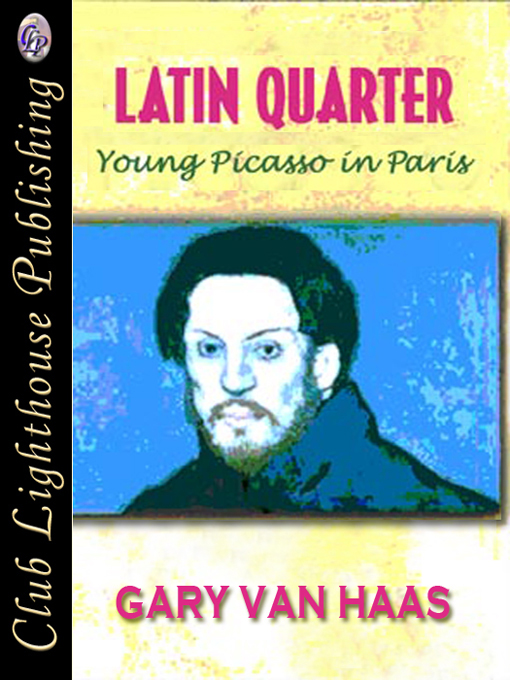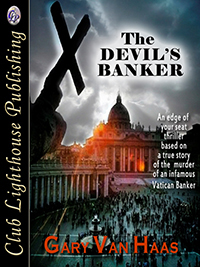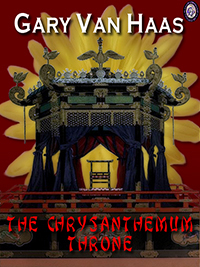|
|


|
NEW eBOOKS AVAILABLE IN 6 FORMATS
Adobe acrobat = PDF
HTML = .htm
Kindle = .mobi
MSReader = .lit
Nook = ePUB
PALM = .pdb
|
HOME >> Product 0290 >> Latin Quarter>>

|

Touch image to enlarge
|
Latin Quarter
GARY VAN HAAS
It is 1925 in Paris, and writer, Gertrude Stein is reminiscing at an exhibition featuring Pablo Picasso's famous art work, 'Les Demoiselles d' Avignon'. She is talking to Count Marbur, explaining the painting to him. The story then moves to Malaga, Spain 1918, where she continues to reveal Pablo's fascinating history.
|
$3.50
|
|
In Malaga, after an illness and death of his little 7 year old sister Maria, distraught young Picasso absorbs himself into painting, so much so that when he enters the Academy of Art in Barcelona at 16, where his father teaches. He surpasses all of them, at which point his father Jose Ruiz y Picasso turns over his brushes and palette as a symbol of his ascendance.
At 19 years old Pablo Picasso takes a train from Barcelona to Paris with his closest friend, Carlos Casagemas, a volatile Spaniard who is also a fellow painter. They are greeted by Carlos' Uncle Don Luis Costa who helps them settle into modest lodgings within the lively Latin Quarter district near the Seine.
While in Paris, he and Carlos meet a colourful cast of characters including notable writers and poets, Apollinaire, Jaime Sabartes, and Max Jacob, a journalist and outspoken political activist, who teaches him the ropes and ways to survive as a young budding artist in the 'City of Light', where competition is fierce from the likes of Henri Matisse, Cezanne, Paul Gauguin, Manet, and many of the other Impressionists, who fiercely defending their newly established style.
While Pablo and his friend Carlos are in Paris, they meet many lovely women and go to wild artist parties where Carlo meets and falls in love with a girl named Anna. But little to his knowledge, 'Anna' has her eyes on Pablo, smelling his eventual success after a show at the famous Vollard's Gallery. Her lying and deception continues until Carlos can take it no more and shoots himself in the middle of a busy bar in Montmarte, and Pablo is heartbroken. This is where he makes his first Blue Period painting of Carlos in his casket.
During this time Pablo also meets a woman named, 'Fernande Oliver', the first love in his life and they move in together at an apartment building notably called, the 'BATEAU LAVOIR', made famous where he created most of his 'Blue Period' and 'Rose Period' works.
He finally meets art patrons, Gertrude and Leo Stein at a party through Apollinaire and Pablo and she become friends. She introduces Pablo to an influential art critic named, Felix Baton, who is a flamboyant homosexual and immediately fixates on Pablo and wants to control his life, but Pablo won't comply and ends up offending him, creating a powerful adversary that causes him harm from this point on.
On one visit to an art exhibition at 'The Salon Independents', young Picasso is introduced by Apollinaire to Matisse who shows Pablo some African totem sculpture. Pablo becomes infatuated with the totems and begins sketching them, and once he is home he starts making a commissioned portrait of Gertrude Stein in the totem stylized motif.
Fernande and Pablo continue living happily at Bateau Lavoir for a time despite his manager, Ambroise Vollard's dwindling art sales. His paintings are not selling well due to the lack of public understanding of his work and Felix Baton's negative reviews. Eventually they are broke, and Fernande ends up prostituting herself on the streets of Paris in order to bring in enough money for them to eat and live.
They are finally evicted from Bateau Lavoir for failing to pay their rent and are forced to leave Paris for cheaper lodging in the mountains of Gosol, Spain.
While in Gosol, Pablo paints feverishly to the point of deteriorating health, in search of a new style to pull them out of their gloomy situation. With lack of canvas available, Pablo paints over many of his great masterpieces much to the dismay of Fernande who thinks he lost his mind. Until one day when they are arguing a mirror is broken and he see the shards of glass on the floor in hundreds of wedges looking back at him. He has discovered something; a way to see almost all around a subject on canvas that becomes the birth of 'Cubism'…..
|
|
Length:
|
35781 Words
|
|
Price:
|
$4.50
|
|
Sale Price:
|
$3.50
|
|
Published:
|
2012
|
|
Cover Art:
|
Gary Van Haas
|
|
Editor:
|
Terrie Lynn Balmer
|
|
Copyright:
|
Gary Van Haas
|
|
ISBN Number:
|
978-1-927337-26-4
|
|
Available Formats:
|
PDF; HTML; Microsoft Reader(LIT); MobiPocket (PRC); Palm (PDB); Nook, Iphone, Ipad, Android (EPUB); Older Kindle (MOBI);
|
|
|
IN AN INFORMAL SOMEWHAT stuffy, cluttered salon in Paris in May 1925, a group of conservative elites had gathered to pass judgement on Picasso's bizarre, twisted 96x92 inch cubist painting of prostitutes in a whorehouse titled, "Les Demoiselles d' Avignon". The work originally titled, The Brothel of Avignon, was now commonly referred to as, "The Young Ladies of Avignon".
The "Avignon" painting portrayed five nude female prostitutes from a brothel on Avinyó Street in Barcelona, each woman depicted in a disturbing yet provocative manner of which none are notably feminine. The ladies are shown slightly intimidating, rendered with angular and incoherent body shapes. Yet two of the women singled out appear to be wearing African-like masks on their faces, while three of the others were shown in the Iberian style of Picasso's native Spain, giving them an almost feral, ferocious appearance. Demoiselles was Picasso's unique creation of Primitive Art, with its total disregard of perspective, relying mainly on a flat, two-dimensional picture plane, heralding the young artist's fundamental departure from traditional European painting. The painting at the time was considered to be scandalous, but is now considered to be one of Pablo's major breakthroughs, heralding the advent of modern art.
* * * * *
COUNT REGINALD DANELLI MARBUR, a handsome, young dandy and aristocrat of Franco-Italian affluence, in his late twenties, leaned nonchalantly on his cane, staring at the painting. Dressed formally, wearing black tails with white waistcoat, necktie and a fashionable Homburg black-silk top-hat, he observed the new Picasso work with more than casual interest.
Marbur had been in conversation with a rather staid, heavy-set looking woman standing next to him. She was the well-known art collector and connoisseur, Gertrude Stein; in her mid-thirties, with her hair tied severely back in a tight bun.
"Gertie," as she was affectionately called by her friends, was not one for frill or fanciful garments and normally wore unpretentious clothing, unlike the other leisurely ladies of her day who strutted about the busy boulevards in fashionable "Silhouette S" dresses, revealing full, low-cut chest and curvy hips for all eyes to envy. She also obviously never used perfume and there hovered a faint, unpleasant smell about her.
'Frankly,' said Count Mabur, looking blankly at the Demoiselles painting, holding a scented handkerchief to his straight, aquiline nose, 'I don't quite see what all the fuss is about, nor do I understand it. What does the painting mean, pray tell?'
She side-glanced him as if one were to forgive such ignorance.
'To understand Picasso, one must understand the life of the artist,' she said firmly, and as she turned to walk away, the curious Count, thinking he had in some way offended her, quickly followed to catch up holding tightly onto his top hat. As she strolled briskly ahead moving under the thorny rose trellis leading into the gardens, he called out to her.
'Hold up, Gertie. Do go on,' he said. 'I want to hear more about him. He sounds absolutely intriguing.'
She paused, smiled to herself, shaking her head, knowing full well she had his attention.
'Come, sit here beside me,' she said taking his hand, lowering her broad frame down into a seat on a green garden bench. 'It all began long ago with Pablo's father, who was also quite talented...'
|
|
5.0 out of 5 stars Picasso as you never knew him! June 15, 2012
By Paulina Ioannidou
Even the name alone, LATIN QUARTER, conjures up images of a most intriguing and fascinating time at the turn of the century when Paris was awash with famous writers, artists and intellects of the time. It remains one of the most colorful, creative and progressive ages for the Arts. In the center of this whirlwind is Pablo Picasso as you never met him--a young, dashing and arrogant young Spaniard, who, in a few short years came in to rock the Art world and the powers that be to their very foundations, changing the course of Art, opening up a whole new dimension and way of seeing, what had been traditional and established through the works of Matisse, Cezanne, Renoir, Monet--to name but a few--bringing Art to a whole new level.
It was never the same again.
What I found intersting about THIS book--and there have been no shortage of books and films over the years about Picasso--is the forming of this young genius, the impetus and driving force behind him, his early struggle and the lean years, rubbing shoulders with all the greats in painting, sculpture, and literature. Smashing established mores of the times against all odds, freeing the senses, following his heart and his destiny to the heights it would eventually take him. Here was a man that was true to himself at the expense of all else.
As an artist myself I found this book an inspiration especially during the times we find ourselves in today--the lack of individualism and fear of being different--to take that leap with total faith and belief in oneself into the unknown. It's heady stuff!
By all means READ THIS BOOK--and enjoy!
5.0 out of 5 stars If You Love Picasso, You'll absolutely Love LATIN QUARTER May 15, 2012
By Paul Johnston, PhD
This very indepth story of Pablo Picasso's beginnings as an artist and his little known developmental period in Paris in early 1900 was a fabulous read that has all the ingredients for a major blockbuster film and best seller worldwide.
If You Love Picasso, You'll Love LATIN QUARTER.
To submit a review for this book click
here
|
|
|



|
|
|
|
|
|
|
Pablo Picasso, painting, cubism, death, friend, Paris, Siene, Latin, uncle, journalist, poets, writers, City of Light, Henri Matisse, Cezanne, Paul Gauguin, manet, Impressionists, deception, critic, Gertrude Stein, homosexual, adversary, portrait, Spain, Malaga,Gosol, prostitute, masterpieces,reviews,
Home
║
Privacy Notice
║
FAQ
║
Site Map
║
Contact Us
|
|








